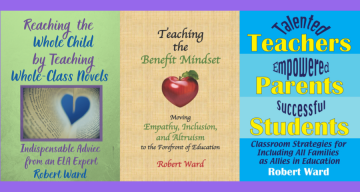Any teacher who wishes to have their students interact and work together must keep in mind four overarching aspects of collaborative learning.

1. The Group Work Litmus Test
A good test for whether group work is even necessary for a particular assignment is this:
After you have provided your students with the essential knowledge and skills, if the vast majority can successfully complete an assignment while working individually, with very little teacher assistance, then no group or partner work is needed.
It is as simple as that.
Just because students like to work together and it seems to make things easier to pacify them, those are not enough justification for group work. Just because it may appear to some that you are a super teacher because your students are perpetually seated in groups, that in and of itself is not a good reason for collaborative learning. In fact, these weak rationales for group work will probably backfire on you.
As I write in my book, Reaching the Whole Child by Teaching Whole-Class Novels, you must have very specific reasons for your students to collaborate on any given assignment. These justifications must satisfy your own scrutiny, as well as that of parents and administrators who are looking for a challenging, meaningful learning experience for every student—not merely a free-for-all where students chatter away while individually completing an assignment that never necessitated their classmates’ assistance or input.
Similarly, if it makes your life easier to have your more attentive (not necessarily more skilled) students re-teach to their lackadaisical partners what all students should easily have been able to grasp on their own had they been focused during direct instruction, then you are allowing your more conscientious students to “enable” inattention in others, which only makes the problem continue. You are even allowing those mindful students’ learning time to be wasted in helping others who clearly aren’t helping themselves.
True group work isn’t about students merely helping or re-teaching each other; it’s a synergistic process that yields a product greater than the sum of its parts.
Be honest and prudent about how ready both you and your students are for serious, successful group work. Re-examine the assignments you have planned for group work, and make certain they pass this simple litmus test. Also, re-assess if your classroom management during direct instruction and individual class work is functioning to your satisfaction. If not, sharpen your management skills before launching into group work. Group work that is well planned and well executed is always worth the wait!
(It is acknowledged that sometimes group work is logistically necessary. If you only have a limited number of books, manipulatives, microscopes, etc. then sharing the wealth is the only choice. Nevertheless, seize this necessity of cooperation as an opportunity for you to also incorporate some collaborative component. “Fuller, richer, and deeper” should always be the words to guide your lesson planning for groups.)
2. Collaborative, Not Cooperative, Groupings
Note the distinction between “collaborative” and “cooperative” learning. Of course, cooperation is a cornerstone of any teacher’s game plan and is always occurring in a well-functioning classroom, but actual collaboration is the hallmark of legitimate group work.
Therefore, if a task does not absolutely necessitate two or more students working closely together, where each individual is contributing an equal, necessary, and vital element to the end product and where two or more minds are achieving something much greater than one individual could produce on their own, then just leave that particular assignment to the individual.
Instead, save your most demanding and profound assignments for groups. You’ll have much better management and academic results with groups when your students are deeply involved in a truly daunting task. Greatly reduce your students’ opportunity and temptation to socialize or fade out by only assigning them something serious and compelling to accomplish during those instances when you give them the well-earned privilege and excitement of collaborating with their peers.

3. Complexity is King for Group Work
Students need a reason to collaborate, and that reason always comes from complexity. The distraction, socializing, and bickering that can occur when students work with each other often stem from the lack of complexity of the assignment itself.
There used to be a teacher axiom to “keep students so busy, they don’t have time to fool around.” While mindless worksheets and endless busywork are thankfully things of the past, there is a grain of truth in that old adage. If we substitute the word engaged for the word busy, we can see the motivational power that meaningful assignments engender.
The real reason to collaborate is because a task is intricate and sophisticated; it is too difficult and has too many pieces to complete alone. Approached in the right way, every student will rise to a challenge—as long as that challenge is deemed worthy of their effort, students have some choice in the matter, and they have some stake in the outcome.
This is why project-based and problem-based learning are perfect for fruitful group work. Add a deep sense of purpose and passion to PBL, and your students’ engagement transforms into investment!

4. Prepare Students to be Good Team Members
According to Sweeney (2010), there are seven Ps for students to follow when working collaboratively:
Pausing, paraphrasing, and probing are great ways to extend collaborative conversations. Teachers use these techniques all the time during class discussions, so have your students mirror these same talking techniques.
Putting ideas on the table is the logical result of productive student conversations. Without the first three Ps, students will not have the benefit of every member’s full participation and thoughts.
Paying attention to oneself and others and presuming positive intentions both require the self-awareness and respect that ensure group work is serious and rewarding. Those petty student arguments so common in other classrooms will not occur in a setting of mutual courtesy and cooperation.
Pursuing a balance between advocacy and inquiry entails that students truly want to collaborate. If there are students who are fixated on seeing that only their ideas and input are ultimately used, then why collaborate in the first place?
Collaboration is the act of discovering and learning together. Use these four tips to make group work a positive and productive learning experience for all.
***

If you liked this article, you’ll love my new book, Reaching the Whole Child by Teaching Whole-Class Novels. It’s my love letter to ELA teachers who want to teach with equal parts practicality and passion!
This article was also featured in the Top 10 of articles about PBL on the BIE.org website and on myPBLworks.org.
You’ll also enjoy reading the 10 articles I’ve written for Edutopia.





Another great blog! So often, we hear teachers say to students, “Get into groups” without any purpose or procedure. Robert’s article respectfully explains the value of the why and the value of the structure. In addition, group work is meant to be meaningful, and is often accompanied by some academic and behavior struggle. But, it is within this productive struggle that students realize the critical importance of working together. Thank you, Robert, for your article…I will certainly share it with my colleagues!
LikeLiked by 1 person
Thank you, Peg, for your kind words and insights. Purposeful, productive struggle is a part of learning and growing– and it becomes even more powerful (and fun!) when we strive toward a common goal with our peers.
LikeLike
LikeLike
https://twitter.com/SueAtSea/status/984224982246084609
LikeLike
LikeLike
LikeLike
LikeLike
LikeLike
LikeLike
LikeLike
LikeLike
https://twitter.com/misterwilson/status/1115992393168216065
LikeLike
LikeLike
LikeLiked by 1 person